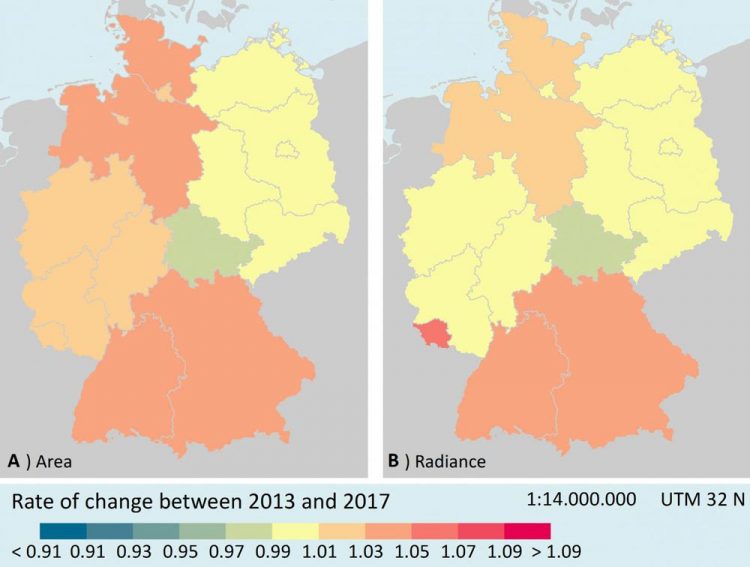German nights get brighter — but not everywhere

Map of German federal states ('Bundeslaender') and light pollution: Nearly all states got brighter with one peculiar exemption: Thuringia in the eastern part of Germany got darker over the last four years. Credit: C. Kyba / T. Küster / H. Kuechly for the GFZ
The nights in the German federal states („Bundesländer”) have been getting brighter and brighter – but not everywhere at the same rate and with one peculiar exemption: light emissions from Thuringia decreased between 2012 and 2017.
This is the result of a recent study by scientists Chris Kyba and Theres Küster from the GFZ German Research Centre for Geosciences together with Helga Kuechly from “Luftbild – Umwelt – Planung, Potsdam”. Kyba and colleagues published the study in the International Journal of Sustainable Lighting IJSL. This week, they updated the maps by including the 2017 data from a satellite-born instrument.
The team measured the change of light emissions for every German state, studying both the lit area and total radiance. The trends in the lit area show a clear distinction between East and West. The lit area of the states of the former GDR including Berlin stayed basically the same (growth less than 1 per cent), whereas the states in the western part of Germany increased in the area that is lit in the night.
The lit area in Thuringia decreased by about 7%. With respect to the intensity of the lighting, the picture is more complex. Large areas in both East and West Germany show only marginal changes, while some states show growth rates of three to four per cent annually. Once again, Thuringia decreased in radiance.
The trend towards increasing night light emissions could be explained by a widespread change in outdoor lighting: LED lamps are replacing older technologies, and changing the ways in which light is used in both public and private lighting.
The researchers are still in the dark as to the reason why Thuringia shows a decreasing trend. In the study in IJSL which did not include the 2017 data, two other states appeared to decrease from 2012 to 2016: Saxony and Saxony-Anhalt. This trend, however, vanished after the team re-calculated the changes with the latest data from 2017.
Chris Kyba can only guess why Thuringia sticks out. “Maybe the data reflect the fact that older high pressure sodium lights are aging and decreasing in brightness,” says Kyba. On the other hand, it could as well be that municipalities have already changed to LED lights, which appear darker to the satellite. The instrument that measured the changes, the Visible Infrared Imaging Radiometer Suite Day Night Band (DNB), detects light with wavelengths between 500 and 900 nanometers, corresponding to the colours green to red, and including invisible infrared.
White LED light includes a large component of blue light that the DNB instrument is not sensitive to. “So maybe Thuringia only looks darker simply because of the satellite's inability to see the blue light emitted from LEDs”, says Kyba. He adds: “We definitely intend to follow up on this in the next years to understand the reasons behind lighting change in all of the states.”
###
Original study: C. Kyba et al.: Changes in outdoor lighting in Germany from 2012-2016, in: International Journal of Sustainable Lighting IJSL (2017) http://www.
Media Contact
All latest news from the category: Earth Sciences
Earth Sciences (also referred to as Geosciences), which deals with basic issues surrounding our planet, plays a vital role in the area of energy and raw materials supply.
Earth Sciences comprises subjects such as geology, geography, geological informatics, paleontology, mineralogy, petrography, crystallography, geophysics, geodesy, glaciology, cartography, photogrammetry, meteorology and seismology, early-warning systems, earthquake research and polar research.
Newest articles

Silicon Carbide Innovation Alliance to drive industrial-scale semiconductor work
Known for its ability to withstand extreme environments and high voltages, silicon carbide (SiC) is a semiconducting material made up of silicon and carbon atoms arranged into crystals that is…

New SPECT/CT technique shows impressive biomarker identification
…offers increased access for prostate cancer patients. A novel SPECT/CT acquisition method can accurately detect radiopharmaceutical biodistribution in a convenient manner for prostate cancer patients, opening the door for more…

How 3D printers can give robots a soft touch
Soft skin coverings and touch sensors have emerged as a promising feature for robots that are both safer and more intuitive for human interaction, but they are expensive and difficult…




















